Tropical Fruit Selections
We have carried this selection of tropical fruit plants. Availability and sizes change.
Please call or e-mail for specifics on varieties, pricing, and sizes.
|
Note: Due to heavy demand for Tropical Fruit plants, we are often sold out. Please call ahead to confirm availability. |
Plants are in alphabetical order by botanical names.
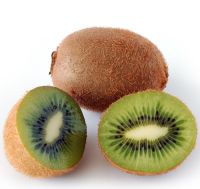 |
Common Name: Kiwi, Kiwifruit male Latin Name: Actinidia deliciosa 'Matua' Family: Actinidiaceae Origin: China Hardiness: USDA Zone 8-10 - leaf damage at 29° F, dormant vine damage at 10° F |
Male variety 'Matua' - pollinates most all other varieties, very vigorous, cold hardy, no fruit. One male will pollinate 8 females if close enough. |
 |
Common Name: Kiwi, Kiwifruit female Latin Name: Actinidia deliciosa 'Saanichton' Family: Actinidiaceae Origin: China Hardiness: USDA Zone 8-10 - leaf damage at 29° F, dormant vine damage at 10° F |
Female variety, 'Saanichton' - large, tasty fuzzy fruit pollinates with 'Matua', cold hardy. Harvest is late autumn. |
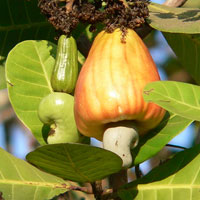 |
Common Name: Cashew nut, Cashew Apple Latin Name: Anacardium occidentale Family: Anacardiaceae Origin: Northeast Brazil Hardiness: USDA Zone 10 - damage at 30-32° F |
Fast growing, can fruit in just two years. Grows 10 to 12 feet tall, protect from freezing. Cashew nuts must be roasted before eating. |
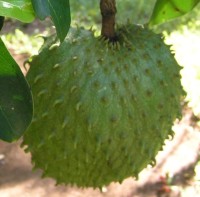 |
Common Name: Soursop, Guanabana Latin Name: Annona muricata Family: Annonaceae Origin: Caribbean and Central America Hardiness: Damage temp: 41° F |
8 to 12 inch prickly, green fruit is juicy, acid, white, and aromatic. Broadleaf, flowering, evergreen tree grows up to 13 feet tall. |
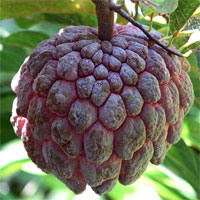 |
Common Name: Sugar Apple Latin Name: Annona squamosa Family: Annonaceae Origin: Tropical America (perhaps Caribbean) Hardiness: Damage temp: 28° F |
Softball size fruit, tasty and sweet like custard. Pulp in segments containing a seed easily separated from the fruit. Grows 8 to 10 feet tall and can produce fruit in as little as two years. |
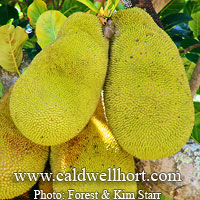 |
Common Name: Jackfruit Latin Name: Artocarpus heterophyllus Family: Moraceae Origin: India or Malaysia Hardiness: USDA Zone 10, can take short periods of 32° F |
| The fruit of the Jackfruit is the largest treeborn fruit in the world! Seldom less than 10 inches in diameter, they can weigh up to 80 pounds each (in tropical regions). The fruit is popular in many parts of the world. The taste is something of an acquired taste and said to resemble pineapple, cantaloupe, or fruit salad. The tree is frost sensitive. |
 |
Common Name: Carambola, Starfruit, Five-finger Latin Name: Averrhoa carambola Family: Oxalidaceae Origin: Southeast Asia Hardiness: USDA Zone 9b Damage temp: 26-28° F |
A small symmetrical tree with prolific fruit production. The sweet citrus like flavor is delicious and refreshing and used in salads, drinks, garnishes, and eaten fresh from the tree. |
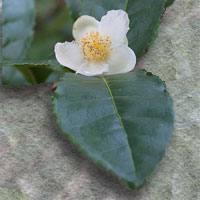 |
Common Name: Tea Latin Name: Camellia sinensis Family: Theaceae Origin: Mainland South and Southeast Asia Hardiness: USDA Zone 8 |
Tea has been cultivated for almost five thousand years in China. Today it is the most popular drink in the world next to plain water. The Tea plant is a species of Camellia and tea is made from the dried and cured new buds produced in spring. Flowers are yellow/white. |
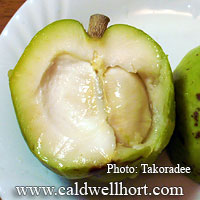 |
Common Name: White Sapote, Mexican Apple Latin Name: Casimiroa edulis Family: Rutaceae Origin: eastern Mexico and Central America south to Costa Rica Hardiness: USDA Zone 9 |
| Evergreen tropical persimmon tree 15 to 40 feet tall. Delicious fruit is creamy white to beige-yellow and range in flavor from banana-like to peach to pear to vanilla flan. |
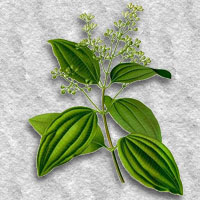 |
Common Name: True Cinnamon Latin Name: Cinnamomum zeylanicum Family: Lauraceae Origin: Sri Lanka (Ceylon) Hardiness: Damage temp: 30-32° F |
An evergreen shrub or small tree with dark, leathery, aromatic leaves used as spice and in candy, gum, incense, and perfumes. This is true Cinnamon, not the Cassia substitute so often seen in the marketplace. |
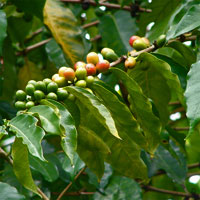 |
Common Name: Coffee Latin Name: Coffea arabica Family: Rubiaceae Origin: Ethiopia Hardiness: Damage temp: 28-30° F |
| Coffee plants are small tropical trees growing to 15 feet tall with small white, fragrant, star-shaped flowers.. They resemble gardenias to which they are related. The edible fruits are small fleshy berries changing in color from green to yellow to red. The seeds can easily be dried, roasted and ground at home. The plants are traditionally grown in the shade of larger plants but will also flourish in full sun. |
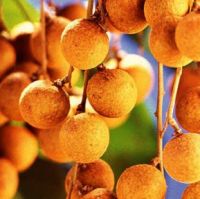 |
Common Name: Longan Latin Name: Dimocarpus longan Family: Sapindaceae Origin: Southeast Asia Hardiness: Damage temp: 40° F |
| Like Lychee but a bit more cold hardy! Extremely sweet fruit. |
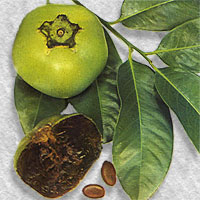 |
Common Name: Black Sapote, Chocolate Pudding Fruit Latin Name: Diospyros digyna Family: Ebanaceae Origin: Mexico Hardiness: Damage temp: 28-30° F |
| An evergreen tree with dark green glossy leaves. The fruits are greenish-brown when ripe having a thin skin and chocolate colored pulp. A spoonful of honey is mixed into the pulp making a glossy, shiny and tasty treat, living up to its popular name of The Chocolate Pudding Fruit. |
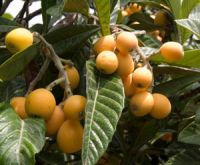 |
Common Name: Loquat, Chinese plum Latin Name: Eriobotrya japonica Family: Rosaceae Origin: Southeastern China Hardiness: USDA Zone 7-10 |
| Fast growing hardy tree that produces small round, yellow orange sweet fruit in clusters. Easy to grow, tropical looking tree. |
 |
Common Name: Gold Nugget Loquat Latin Name: Eriobotrya japonica Family: Rosaceae Origin: Southeastern China Hardiness: USDA Zone 7-10 |
| Hybrid evergreen tree with small round fruits. Loquats are good for blood pressure and regulating blood sugar. |
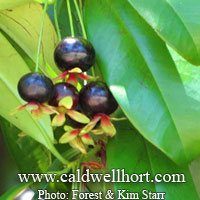 |
Common Name: Grumichama Latin Name: Eugenia brasiliensis (syn. Eugenia dombeyi) Family: Myrtaceae Origin: Coastal Southern Brazil Hardiness: USDA Zone 9b |
| Highly ornamental small tree (25-30 feet) growing best in rich deep loamy slightly acid soil. Fruits are 1/2-3/4" wide dark red, berries with soft, juicy pulp with a delicious cherry like flavor. Can be trimmed as a shrub, grow in sun or shade and provide year round moisture and good mulching. |
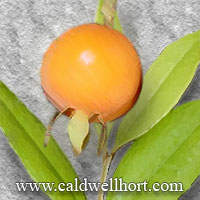 |
Common Name: Pitomba Latin Name: Eugenia luschnathiana Family: Myrtaceae Origin: Bahia, Brazil Hardiness: USDA Zone 10 |
Pitomba is an attractive, slow-growing tree to 20 or 30 feet high, with dense evergreen foliage. Pitomba fruits have a thin, tender skin and a soft juicy golden yellow aromatic pulp with a slightly acid flavor similar to apricots. The fruit is eaten fresh and makes good jellies and preserves. |
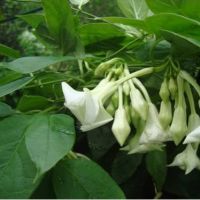 |
Common Name: Loroco Latin Name: Fernaldia pandurata Family: Apocynaceae Origin: Hardiness: 9 |
| Tropical vine with edible flower buds. Important source of food from El Salvador to Guatemala. Grows in sun to partial shade. Limited quantities available. |
| Common Name: Star Anise Latin Name: Illicium verum Family: Schisandraceae Origin: northeast Vietnam and southwest China Hardiness: 9 |
|
| Fast growing evergreen, medium sized tree with straight olive green leaves and soft yellow blooms. |
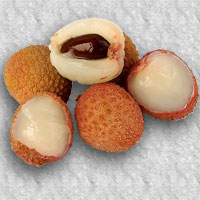 |
Common Name: Lychee Latin Name: Litchi chinensis Family: Sapindaceae Origin: Southeast China Hardiness: USDA Zone 9 - Damage temp: 24-28° F |
Lychees are one of the worlds most relished fruits. They are eaten fresh, out-of-hand, or peeled and pitted and added to fruit cups and fruit salads. For maximum productivity, there must be full exposure to light on all sides. Trees can grow 60 to 100 feet tall. |
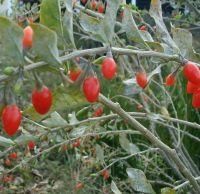 |
Common Name: Goji Berry, Wolfberry Latin Name: Lycium barbarum Family: Solanaceae Origin: China Hardiness: USDA Zone 8 |
|
Rare! Viney bush produces rich, sweet berries very high in nutrients and antioxidants. |
|
Common Name: Macadamia Nut Latin Name: Macadamia integrifolia Family: Proteaceae Origin: Australia Hardiness: USDA Zone 9b-11 |
Macadamia can become a large evergreen tree to 35 feet tall. They can withstand some frost and brief freezing in the mid-20s. Young trees require copious amounts of watering but mature trees are quite drought tolerant. Macadamias are considered to be among the finest table nuts in the world. They contain high quantities of oil. Macadamia nuts are eaten raw, or roasted and salted. The nuts are also used to make an edible bland salad oil. Years ago a coffee-like beverage known as "almond coffee" was marketed from the seeds. (University of California. 2004.) Macadamias are highly nutritious nuts and have the highest amount of beneficial monounsaturated fats of any known nut. |
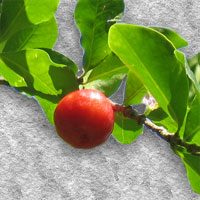 |
Common Name: Barbados Cherry, Acerola Latin Name: Malpighia punicifolia Family: Malpighiaceae Origin: West Indies, Central America Hardiness: Damage temp: 30 to 28° F |
| A fast growing bushy tree to 20 feet tall that can be trained as a standard or shaped as a hedge. Fruits are sweet to sub-acid, and are used extensively in juices throughout Latin America. The cherries are very high in Vitamin C. |
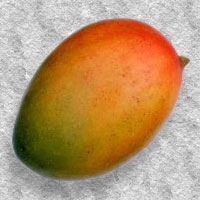 |
Common Name: Mango Latin Name: Mangifera indica Family: Anacardiaceae Origin: Southeast Asia and India Hardiness: Damage temp: 25-27° F |
| Mangos have been grown in India for thousands of years! A world superfruit, Mango is now used worldwide as a source of food, juice, flavor, fragrance and color. They are erect and fast growing with sufficient heat, and the canopy can be broad and rounded, or more upright, with a relatively slender crown. In the tropics Mango trees can grow to 120 feet tall and 30 feet wide but are usually smaller in less tropical areas like Florida and California. They can live to be 300 years old and still produce good fruit. Mango trees make handsome landscape specimens and shade trees. |
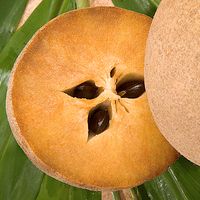 |
Common Name: Sapodilla, Chico, Zapotillo Latin Name: Manilkara zapota Family: Sapotaceae Origin: Yucatan Hardiness: Damage temp: 26-28° F |
| Slow growing, evergreen tree with glossy 4 inch leaves, can grow to 100 feet, but is usually half that. The tree is wind resistant, can tolerate salt spray, and prefers warmth and sun. It can take from 5 to 8 years to bear fruit, but yields twice per year. The fruit is eaten fresh, and is sweet, similar to a pear. |
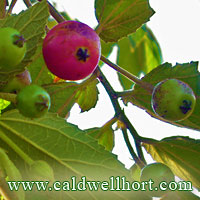 |
Common Name: Strawberry Tree, Jamaica Cherry Tree Latin Name: Muntingia calabura Family: Elaeocarpaceae Origin: southern Mexico, Central America, tropical South America, the Greater Antilles, St. Vincent and Trinidad Hardiness: USDA Zone 10 |
| Fruit is small, tasty, and almost ever bearing. Grows to about 20 feet tall. Jamaica Cherry Tree thrives in poor soil, is able to tolerate acidic and alkaline conditions and is drought tolerant. These cherries are very sweet. The sweetness brings with it an excellent taste. These cherries are often eaten by children because they taste quite like cotton candy. They are just delicious as ripe fruit and for making jam. |
 |
Common Name: Cavendish Banana Latin Name: Musa acuminata Family: Musaceae Origin: Hardiness: USDA Zone |
| Popular bright yellow banana |
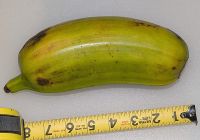 |
Common Name: Hua Moa Banana Latin Name: Musa spp. 'Hua Moa' Family: Musaceae Origin: Hardiness: USDA Zone |
| Cooking banana or can be eaten fresh. |
 |
Common Name: Ice Cream Banana Latin Name: Musa spp. 'Ice Cream' Family: Musaceae Origin: Hardiness: USDA Zone |
| really large cluster desert banana |
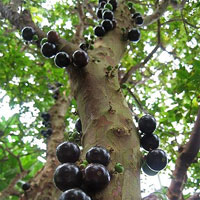 |
Common Name: Jaboticaba Latin Name: Myrciaria cauliflora Family: Myrtaceae Origin: Brazil Hardiness: Damage temp: 25-27° F |
Jaboticaba is a small bushy tree with multiple stems. Fruit is cherry like in appearance with a thicker tougher skin and about 1 inch in diameter. Interestingly, the fruits form on the trunk of the tree and not on terminal branches as most other fruits. Fruits may be eaten out-of-hand, discarding the skin and seeds. They can also be used in jams and jellies, fresh fruit salads, sherbets and cobblers. The tree is cold hardy and likes plenty of water. |
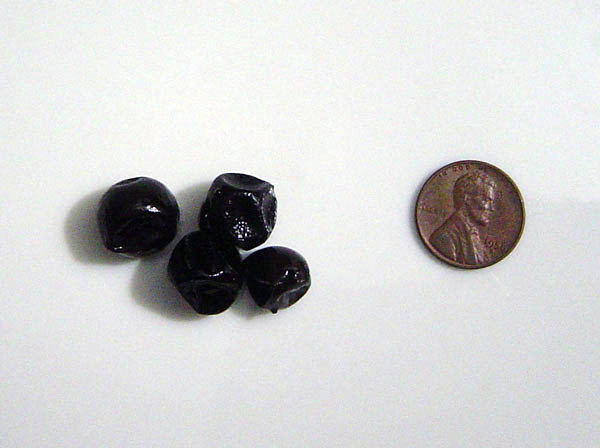 |
Common Name: Guavaberry Latin Name: Myrciaria floribunda Family: Myrtaceae Origin: Central America, South America, Cuba, Dominican Republic, Haiti, Jamaica, Puerto Rico Hardiness: |
| Tropical berry used in drinks that tastes like rum. |
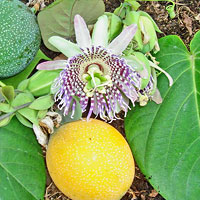 |
Common Name: Sweet Granadilla Passion Fruit Latin Name: Passiflora ligularis Family: Passifloraceae Origin: Mexico through Central America and western South America, through western Bolivia to south-central Peru Hardiness: USDA Zone 9b |
Beautiful showy fragrant flowers and large delicious fruit generally eaten fresh but also used in sherbets and drinks. The vine is a vigorous, strong grower, woody at the base, climbing by tendrils. Granadilla prefers moist cool growing conditions but protect from freezing. |
 |
Common Name: Giant Granadilla Passion Fruit Latin Name: Passiflora quadrangularis Family: Passifloraceae Origin: Tropical America Hardiness: USDA Zone 10 |
| Granadilla is the largest passion fruit and has one of the most beautiful flowers. Introduced into tropical regions around the world, it is thought to have originated in the American tropics. This vine is fast growing with a woody base and attaining a height of 30 to 50 feet or more in the tropics. Flowers are up to 5 inches in diameter and the pleasantly scented melon like fruits are 4 to 6 inches long. For maximum growth and productivity, the vine requires deep, fertile, moist but well-drained slightly acidic soil. vines are set 6.5 to 10 ft apart. Train the vines to grow on a strong, horizontal trellis about 6 feet high. Pruning may be necessary if the growth becomes too dense. Regular applications of fertilizer high in organic matter, and copious watering are necessary. |
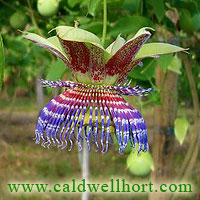 |
Common Name: Sweet Calabash Passion Fruit Latin Name: Passiflora maliformis Family: Passifloraceae Origin: Carribbean and South America Hardiness: USDA Zone 10 |
| This passion fruit vine is woody but slender, climbing to 33 ft. Fruits are about 2 inches long with a hard outer shell. The pulpy interior is pale orange-yellow, juicy, sweet or subacid and pleasingly aromatic. In Jamaica, it is scooped from the shell and served with wine and sugar. The strained juice is excellent for making cold drinks. |
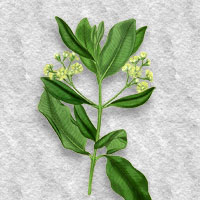 |
Common Name: Lemon Bay Rum Tree, Citrus Bay Latin Name: Pimenta racemosa var. racemosa Family: Myrtaceae Origin: Caribbean Hardiness: USDA Zone 9-10 |
Native to Jamaica, Lemon Bay Rum Tree is closely related to the Allspice Tree. It is a small to medium size tree reaching 20 to 25 feet with evergreen leaves that when crushed emit a lemony bay rum scent. White flowers are followed by oblong black berries. Grow in full sun to light shade. |
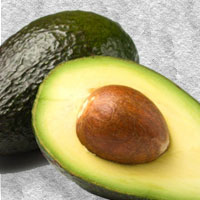 |
Common Name: Avocado - Cold Hardy Varieties Latin Name: Persea americana Family: Sapotaceae Origin: South America Hardiness: USDA Zone 8-11 |
| A large dense and attractive evergreen tree. Grow in full sun with well drained soil, watering frequently during hot weather. Avocados taste best when ripened off the tree. Pick green when mature and let ripen at room temperature. Delicious sliced, in salads, guacamole, or just cut in half and eaten with a spoon. |
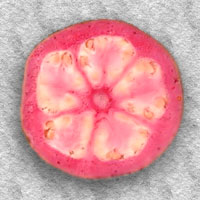 |
Common Name: Guava - Ruby Supreme Latin Name: Psidium guajava Family: Myrtaceae Origin: Native from Mexico to northern South America Hardiness: Damage temp: 25-26° F |
A relatively hardy small tree to 30 feet tall, with spreading branches, the guava is easy to recognize because of its smooth, thin, copper-colored bark that flakes off, showing the greenish layer beneath. Guava is used in jellies, juice, pastries and many other uses. The fruit is smooth, sweet and aromatic. Trees can begin fruiting at one year of age. |
 |
Common Name: Sugarcane Latin Name: Saccharum officinarum Family: Poaceae Origin:South Pacific Islands and New Guinea Hardiness: USDA Zone 9-11 |
| Sugarcane is a tall perennial grass native to China. It has been cultivated in India and China for more than 3,000 years. Grow it in full sun to partial shade in the ground or in large containers. Mulch well and water regularly. Overall plant height can be 12-18 feet tall with 3 foot strap like leaves on canes up to 2 inches in diameter. Children (and adults!) enjoy chewing on the sweet cane centers in fall when are ready for harvest. Sugarcane flowers in the fall with giant plum-like tufts atop the mature canes. Also available: Red Sugarcane |
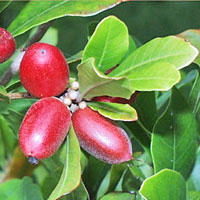 |
Common Name: Miracle Fruit Latin Name: Synsepalum dulcificum Family: Sapotaceae Origin: West Africa Hardiness: Damage temp: 28° F |
An evergreen bush growing to about 18 feet in its natural range but usually around 5 feet in a garden setting. Small white flowers are produced in flushes during the growing season followed by bright red 1 inch berries each containing a single seed. The effect of Miracle Fruit requires eating only a single berry allowing the fleshy pulp to coat the taste buds of the tongue. Within a couple of minutes sour fruit like lemons will taste sweet and delicious. The effect remains for one to two hours. Fruit can be frozen and used later. |
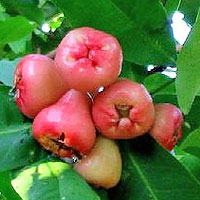 |
Common Name: Wax Jambu, Water Apple Latin Name: Syzygium javanicum Family: Myrtacaea Origin: East Indies Hardiness: Damage temp: 28° F |
A fast growing small tree 25 to 35 feet preferring acid soils for best growth and fruiting. Fruits are bright rose color with a crisp rose like flavor. Evergreen leaves are large to 6 inches long and the fragrant flowers are white and in clusters. The fruit can be eaten out of hand, as a garnish, or in fruit salads. Fruiting is prolific and can begin at just one or two years old. Keep plants around 10 feet tall for easy harvesting. |
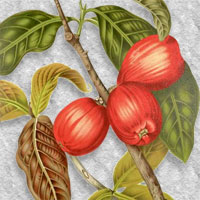 |
Common Name: Malay Apple, Otaheite Apple Latin Name: Syzygium malaccense Family: Myrtaceae Origin: Southeast Asia Hardiness: Damage temp: 30° F |
An attractive fast growing evergreen tree with bell shaped fruit up to 8 inches long with a sweet mild flavor. Leaves are dark green and glossy. Red-Purple flowers are 2 inches across and set in tassel-like clusters. This tree fruits prolifically. |
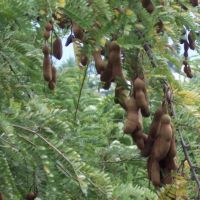 |
Common Name: Tamarind Latin Name: Tamarindus indica Family: Fabaceae Origin: tropical Africa Hardiness: |
| The tamarind is a long-lived, medium-growth bushy tree that grows to a height of 40 to 60 feet. |
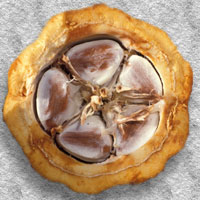 |
Common Name: Chocolate tree, Cacao Latin Name: Theobroma cacao Family: Sterculiaceae Origin: Central and South America Hardiness: USDA Zone 9B - 11 - Damage temp: 33° F |
Cultivated by the Mayas, Chocolate is a 'Food of the Gods'. Cacao is a small evergreen tropical tree with large glossy drooping leaves. It is an understory tree and prefers a constantly warm humid environment. Flowers are small and the fruit forms directly on the trunk of the tree and main branches. Fruiting starts at about 5 years of age. |

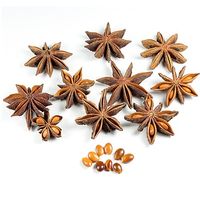

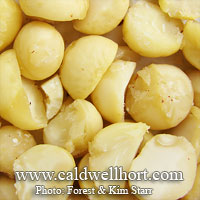
 For General nursery and Bamboo questions
For General nursery and Bamboo questions 

